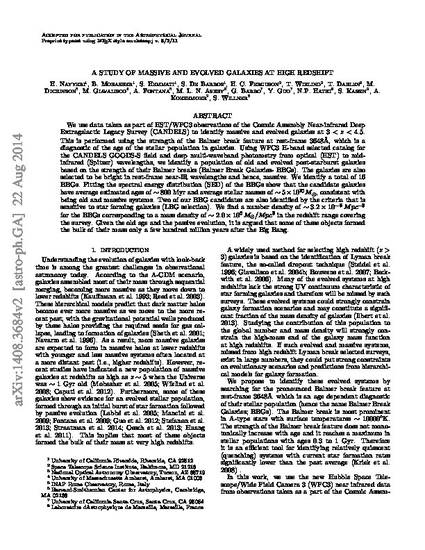
Article
A Study of Massive and Evolved Galaxies at High Redshift
Astrophysical Journal
(2011)
Abstract
We use data taken as part of HST/WFC3 observations of the Cosmic Assembly Near-infrared Deep Extragalactic Legacy Survey (CANDELS) to identify massive and evolved galaxies at 3 < z < 4:5. This is performed using the strength of the Balmer break feature at rest-frame 3648_A, which is a diagnostic of the age of the stellar population in galaxies. Using WFC3 H-band selected catalog for the CANDELS GOODS-S field and deep multi-waveband photometry from optical (HST) to mid- infrared (Spitzer) wavelengths, we identify a population of old and evolved post-starburst galaxies based on the strength of their Balmer breaks (Balmer Break Galaxies- BBGs). The galaxies are also selected to be bright in rest-frame near-IR wavelengths and hence, massive. We identify a total of 16 BBGs. Fitting the spectral energy distribution (SED) of the BBGs show that the candidate galaxies have average estimated ages of ~800 Myr and average stellar masses of _ 5_1010M_, consistent with being old and massive systems. Two of our BBG candidates are also identified by the criteria that is sensitive to star forming galaxies (LBG selection). We find a number density of _ 3:2 _ 10^-5 Mpc^-3 for the BBGs corresponding to a mass density of ~ 2:0x106M. / Mpc3 in the redshift range covering the survey. Given the old age and the passive evolution, it is argued that some of these objects formed the bulk of their mass only a few hundred million years after the Big Bang.
Disciplines
Publication Date
May 2, 2011
Publisher Statement
Prepublished version downloaded from ArXiv. Published version is located at http://iopscience.iop.org/0004-637X/794/1/68
Citation Information
H. Nayyeri, B. Mobasher, H. C. Ferguson, S. De Barros, et al.. "A Study of Massive and Evolved Galaxies at High Redshift" Astrophysical Journal (2011) Available at: http://works.bepress.com/mauro_giavalisco/59/
